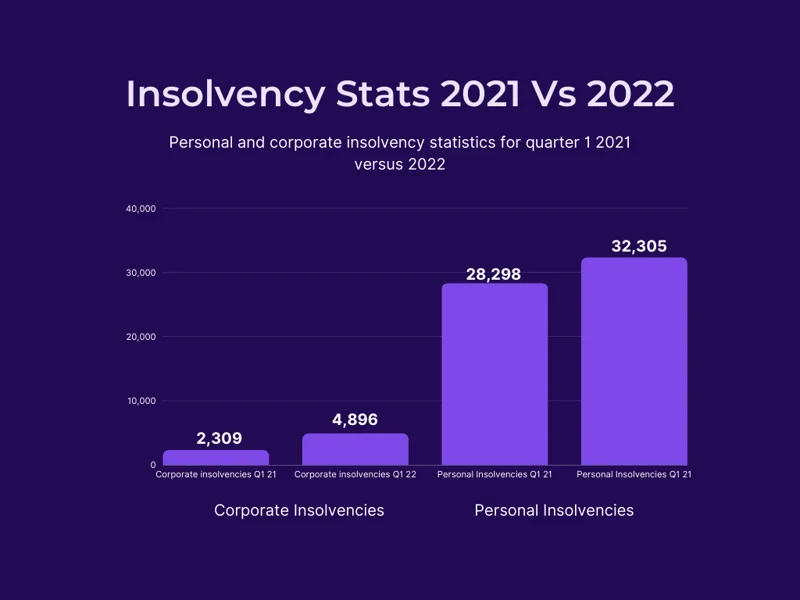With the release of the Q1 2022 statistics, we're eager to see how insolvency figures have shifted since the end of 2021 and compared to this time last year. We’ll delve into the factors influencing national insolvency rates and reflect on what these latest statistics might mean for the country's financial forecast and the future of the insolvency sector two years after the onset of the COVID-19 pandemic.  Figures don’t lie, and in a world filled with PR spin and misinformation, we prefer to stick to our own analysis of the available data. Here are the key insights from Q1 2022 regarding both corporate and personal insolvencies in the UK.  According to R3, there were 4,896 underlying corporate insolvencies and 32,305 personal insolvencies recorded in the first three months of 2022. While these figures might hold significance for those working in the insolvency and restructuring fields, some may need a bit of context to fully understand their implications. Let’s start with the business landscape. R3 reports that 4,896 companies became insolvent in Q1, representing a 6.1% increase from Q4 2021’s figure of 4,615 but a staggering 112% rise compared to Q1 2021’s figure of 2,309. Although this marks only a slight uptick from the end of the previous year, it represents a dramatic surge from the same period last year. This indicates that over the past year, there has been a significant increase in businesses struggling to meet their financial obligations.  While personal insolvencies might not be the primary focus of most insolvency practitioners, keeping track of individual insolvency rates remains crucial as an indicator of how challenging times are for people, not just large organizations. After all, individuals form the backbone of all businesses. So, how do personal insolvencies look in Q1 2022?  R3 notes that "there were 32,305 personal insolvencies in Q1 2022 – an increase of 16.8% from Q4 2021’s figure of 27,668, and an increase of 14.2% on Q1 2021’s figure of 28,298." These statistics reveal that the financial struggles faced by many companies have also impacted individuals, though the brunt of these difficulties appears to weigh more heavily on businesses than on individuals, given the smaller rise in personal insolvencies.  As many businesses closed their doors permanently or sold off assets in the last year, the question arises: Why now? Let’s explore the contributing factors.  Following the initial shock of the pandemic, which disrupted the financial markets and led to a wave of corporate failures, we’ve seen most sectors reopen and return to near-normal operations. Yet, why are so many businesses suddenly failing? A few key factors stand out as major contributors to the current financial challenges facing individuals and organizations alike.  Christina Fitzgerald of R3 comments, “This has been the busiest quarter for corporate insolvencies since 2012 as firms who struggled with the economic aftermath of the pandemic are now grappling with rapidly rising inflation.†Indeed, numerous businesses faced immense pressure in 2020 and 2021 during various lockdowns and restrictions, and unfortunately, many never recovered. The hospitality and leisure industries were particularly hard-hit, and although these constraints on trade are no longer in effect, companies are finding the post-pandemic environment unfriendly.  In terms of economic activity, the anticipated spending spree following the peak of the pandemic didn’t materialize. Instead, any potential profits were quickly absorbed by the surge in inflation and the rising cost of living. It’s undeniable that simply staying afloat is costly today, let alone running a profitable business. As Fitzgerald notes, “The spending boom that never came post-pandemic was the only hope for many businesses. Now that people are cutting back drastically, they can’t bridge the gap with discretionary income. This may partially explain the rise in insolvency rates.† The cost of living crisis is a pressing issue as the prices of essentials like oil and other fuels have skyrocketed. While this affects those directly using the fuel, it also drives up the cost of moving goods by road or sea, making everything more expensive to transport and purchase. In terms of utilities, your latest electricity bill likely reflects the high cost of cleaner energy, making transportation disproportionately expensive compared to typical inflation expectations.  Discretionary income is now a distant memory for both individuals and businesses. The cost of living crisis hits businesses just as hard, if not harder, than individuals, forcing them to decide whether to pass on their rising costs to consumers (who are also struggling) or risk sinking themselves and laying off employees. Credit Connect finds that “rising costs are the biggest challenge facing nearly half of UK businesses in the next six months,†and these costs are inevitably passed on to consumers to prevent the economy from collapsing entirely. Consumers aren’t happy because everything suddenly seems expensive, leading them to cut back on spending. Thus, the cycle continues. The cost of business crisis is just as real as the cost of living crisis, affecting everyone involved.  A BDO survey of “500 medium-sized business leaders reveals that a third will raise the prices of their goods and services in response to rising costs.†Credit Connect also suggests that “almost a third (31%) are seeking additional financing due to rising inflation, rising to two-fifths (42%) in the hospitality and leisure sectors and 36% in retail and wholesale.† You might notice that these are sectors that were severely impacted by the pandemic. Now, surviving companies are turning to loans or other credit-based options to stay afloat. Naturally, this raises concerns about the long-term viability of these businesses. Taking on extra debt without expecting inflation rates to drop soon or sales to skyrocket means one thing—more businesses becoming insolvent and entering administration or liquidation.  For the insolvency sector, it means continued high demand, though this isn’t necessarily good news for the broader economy. The unfortunate reality is that when insolvency professionals are swamped with cases, it signals widespread financial distress. When people lose everything they’ve worked hard for, it’s a sobering reminder of the tough economic times we’re in. Those who started with little face even greater hardships unless measures are taken to address the energy crisis and rein in runaway inflation. Unfortunately, it doesn’t seem poised to improve anytime soon.  While these figures aren’t particularly encouraging for the overall economy, if you’re an insolvency professional without cases on your desk right now, consider yourself lucky. It seems you won’t remain idle for long.  Working in insolvency is an unusual profession. You’re there to help when called upon, yet no one seems particularly delighted to see you. Your presence often signifies failure, at least in the eyes of those whose businesses are faltering.  On the flip side, where would the economy be without insolvency professionals? If creditors turned to the courts instead, they’d incur further costs and still receive little compensation. Managers of failing businesses might sink deeper into trouble without guidance to show them the hard truth. Being overwhelmed by debt is tough enough without bearing the weight of others’ livelihoods on your shoulders.  Insolvency services offer a critical function, and never more so than now as financial markets seem to unravel. It’s often said that things must get worse before they improve. We’re all hoping that’s true for our national economy.  If your workload is overwhelming, Virtual Cabinet can help bring order to the chaos so you can tackle your caseload systematically and efficiently. Organize your case files, reports, and other documents while cleaning up the mess others left behind. Virtual Cabinet understands the insolvency sector and is always ready to demonstrate how seamlessly our Document Management System integrates with major Case Management software.  What are you waiting for? Futureproof your business today with a dedicated Document Management System.   Insolvency refers to a state of being unable to pay debts, applicable to both individuals and companies. Liquidation, however, specifically describes the legal dissolution of a limited company. Once all assets are liquidated (converted to cash), the company is officially dissolved and can no longer accrue debt. Essentially, a company can be declared insolvent due to unpaid debts but this doesn’t always lead to liquidation. There are situations where a company can recover from insolvency with assistance from an insolvency service.  Corporate insolvency pertains to companies, businesses, and organizations whose total liabilities exceed their assets (balance sheet insolvency) or lack sufficient cash flow to meet immediate debt obligations (cash insolvency). When a business can’t pay its creditors, it becomes insolvent. At this point, an insolvency practitioner steps in to organize the company’s assets, debts, and financial commitments to ensure fair distribution of what is owed. The qualified practitioner may sell off assets, restructure the business, or initiate liquidation, selling off all company assets. The alternative to corporate insolvency is individual insolvency.  Also known as personal insolvency, individual insolvency refers to the state of an individual unable to repay their debts and declared insolvent. While not a strict legal term, it generally applies to someone who owes more than £5,000 to a creditor and either: Or Water Sports Ski Rope,Tow Rope For Tubing Ski Rope,Pe Rope Hollow Braided Rope Sichuan AIDIAO Industry and Trade Limited Company , https://www.idaovlai.comWhat Do the Quarter 1 2022 Insolvency Statistics Tell Us About the Economic Outlook?
Insights from the Numbers

Corporate Insolvencies
Personal Insolvencies
Why Are More Businesses Failing Now?
-Post-Pandemic Pressures

-Cost of Living Crisis

What Does This Mean for the Future?

Final Thoughts
FAQs
What’s the Difference Between Insolvency and Liquidation?
What Are Corporate Insolvencies?
What Are Individual Insolvencies?